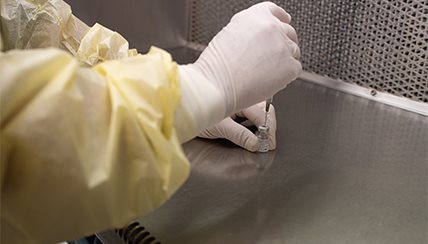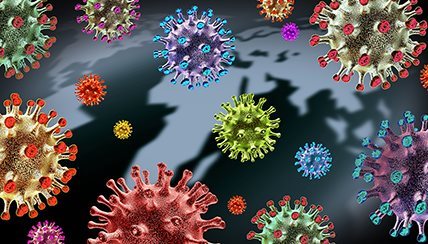Types of Vaccines
 The Pfizer, Moderna, and Johnson & Johnson COVID vaccines are currently available for all U.S. citizens. However, the mRNA vaccines are highly preferred.
The Pfizer, Moderna, and Johnson & Johnson COVID vaccines are currently available for all U.S. citizens. However, the mRNA vaccines are highly preferred.
The Moderna and Pfizer vaccines offer minimal protection after the first dose and fuller immunity within seven days of the second dose. The CDC also recommends that recipients of these vaccines get a booster shot five months after their second dose. The Johnson & Johnson vaccine is a single dose. However, recipients of the J&J shot should also receive a booster of either one of the mRNA vaccines (Pfizer and Moderna) after two months.
It is recommended that you be vaccinated as soon as you are eligible with any of the three approved vaccines, per the State of Colorado's vaccine distribution plan. The COVID mRNA vaccines are preferred over the Johnson & Johnson shot. However, the CDC has outlined certain situations in which the J&J vaccine should be considered.
Read our FAQs to learn more about third shots, boosters and more. |
Viral Vector Vaccine by Johnson & Johnson (Janssen)
On February 27, 2021, The Food and Drug Administration (FDA) announced an Emergency Use Authorization for the Johnson & Johnson (Janssen) COVID-19 Vaccine (JNJ-78436735). ). The EUA was paused April 13, 2021 and amended April 23, 2021 to include risk of rare blood clot in women under age 50. This single-dose vaccine is for people 18 years old and older, and has shown to be 72% effective at preventing all COVID-19, 86% effective at preventing severe cases of the disease and protecting across countries with different variants. The Johnson & Johnson (Janssen) COVID-19 Vaccine is a viral vector vaccine that uses disabled genetic material from the common cold virus (adenovirus) so it won’t make people sick or allow the COVID-19 virus to reproduce.
Download the Johnson & Johnson (Janssen) COVID-19 Vaccine to Prevent COVID-19 Fact Sheet to learn more.
mRNA Vaccine by Pfizer
On December 11, 2020, the Food and Drug Administration (FDA) announced an emergency use authorization (EUA) for the Pfizer-BioNTech COVID-19 vaccine. This vaccine is reported to be approximately 95% effective at preventing COVID-19. The two-dose vaccine claims protection is achieved 7 days after the second dose, which is delivered 21 days after the first dose, with no serious safety concerns observed.
On May 10, 2021, the U.S. Food and Drug Administration expanded the emergency use authorization (EUA) for the Pfizer-BioNTech COVID-19 Vaccine to include adolescents 12 through 15 years of age. The FDA amended the EUA originally issued on Dec. 11, 2020 for administration in individuals 16 years of age and older.
On August 23, 2021, the FDA approved the first COVID-19 vaccine. The vaccine has been known as the Pfizer-BioNTech COVID-19 Vaccine, and will now be marketed as Comirnaty, for the prevention of COVID-19 disease in individuals 16 years of age and older. The vaccine also continues to be available under emergency use authorization (EUA), including for individuals 12 through 15 years of age and for the administration of a third dose in certain immunocompromised individuals.
On September 22, 2021, the FDA amended the emergency use authorization (EUA) for the Pfizer-BioNTech COVID-19 Vaccine to allow for use of a single booster dose, to be administered at least six months after completion of the primary series in individuals 65 years of age and older; individuals 18 through 64 years of age at high risk of severe COVID-19; and individuals 18 through 64 years of age whose frequent institutional or occupational exposure to SARS-CoV-2 puts them at high risk of serious complications of COVID-19 including severe COVID-19. See Pfizer Fact Sheet.
On November 3, 2021, the CDC recommended the use of Pfizer’s mRNA COVID vaccine for children ages 5 to 11. This advisory was later updated to encourage an additional dose of the Pfizer shot for some immunocompromised children.
Download FDA Fact Sheets: Pfizer Fact Sheet ages 12+ | Pfizer Fact Sheet ages 5-11
mRNA Vaccine by Moderna
On December 18, 2020, the FDA granted the Moderna mRNA vaccine EUA status. Early results indicated that the vaccine was safe and produced high levels of antibodies to the SARS-CoV-2 virus. This vaccine is also reported to be approximately 95% effective. The initial Moderna vaccination consists of two doses, delivered 28 days apart.
On November 19, 2021, the FDA amended the emergency use authorizations for the Moderna COVID-19 vaccine to approve the use of a single booster dose for all individuals 18 years of age and older after completion of primary vaccination with any FDA-authorized or approved COVID-19 vaccine. An additional booster is also recommended for immunocompromised individuals five months after receiving the last primary shot.
On January 31, 2022, the FDA approved the Moderna COVID-19 vaccine, which will now be marketed as Spikevax.
Common Types of Vaccines
1. Inactivated Vaccines use the specific virus or bacteria (pathogen) after it’s been killed with heat or chemicals. The dead pathogen is introduced into the body but can still teach the body’s immune system how to fight the live versions of the pathogen in the future. In the United States, the injected polio is an example of an inactivated vaccine.
2. Live, Attenuated Vaccines use a weakened (attenuated) version of the living virus or bacteria. These vaccines are close to a natural infection so they teach the immune system how to fight the full strength pathogen. Live, attenuated vaccines do not cause serious disease in people with healthy immune systems. Chickenpox, and the measles, mumps and rubella vaccines are examples of this type of vaccine.
3. DNA/RNA or Genetic Vaccines use a small part of the pathogen’s genetic information to cause an immune response without causing disease or harm.
4. Vector Vaccines take a “harmless” non-infecting virus, or made one in the lab, and “infuses” it with a potential target protein to create a “vector” virus. Injecting this vector virus into human body tricks the immune system into thinking that it is facing a real infection and causes an immune response to be generated and stored for future reference.
This information has been reviewed and approved by Lisa Maier, MD and Rosine Angbanzan, MPH (February 2022)
| The information on our website is medically reviewed and accurate at the time of publication. Due to the changing nature of the COVID-19 pandemic, information may have since changed. CDC.gov and your state’s health department may offer additional guidance. |


